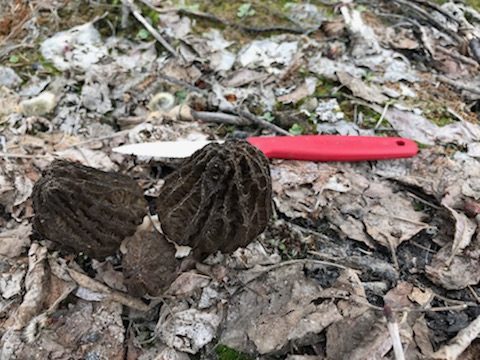
Almost a year ago on June 5, 2019, a lightning strike ignited the Swan Lake fire on the Kenai Peninsula. The fire burned more than 167,000 acres.
The remnants of that fire likely created prime habitat for morel mushrooms. And one ecologist hopes to crowdsource where hunters are finding them to understand more about the fungi.
But how do you get people who are inherently secretive about where they find morels — to tell you where they find their morels?
“Mushroom people don’t like to tell others where they found their mushrooms,” said Kate Mohatt, an ecologist with the Chugach National Forest. “I certainly don’t.”
She helped co-organize the Girdwood Fungus Fair and the Cordova Fungus Festival — and she started the Turnagain Arm Mycological Society.
“It’s appealing to me because it’s a really understudied, but really important group of organisms.”
Mycology is the study of mushrooms and fungi. There’s a lot that we still don’t know about them.
“It’s a hugely diverse, hugely complex group of organisms and there just aren’t that many mycologists,” she said. “Secondly, you know, the mushrooms are the exciting part, but most fungi are microscopic. They’re considered microbes. They’re under the ground or they’re in the substrate and you can’t see them most of the time. So that makes studying them really challenging.”
But we do know they play a critical role in the forest ecosystem. Mohatt says mushrooms and fungi help breakdown tough debris and plant material. They also help support tree growth.
And Mohatt says morels have adapted to fire.
“Fire seems to trigger these mass fruiting events,” she said. “Lucky for us, they’re choice edible mushrooms. So after the fire, the great opportunity to have an abundance of a trace edible mushroom coming out of the ashes.”
Now Mohatt wants to crowdsource mushroom hunters for the information on where they find their morels.
She typically finds burn morels in the areas that were black spruce habitat before the fire.
There are a lot of theories on why morels like to fruit after a large wildfire – but there’s not a lot of hard data on the morels.
Mohatt hopes observation data collected through the project can help scientists study the burn morels. Information on the Swan Lake Fire Burn Morels project can be sent to https://www.inaturalist.org/projects/swan-lake-fire-burn-morels.
And if you’re hesitant about sharing the location of your secret patch, Mohatt says two things can help.
“Morels (are) different. They only come up a year, up to three years after the burn. And that’s really the first year that you get the big flush.”
And two, you can wait until after the season is over before reporting your data.
“We’re encouraging folks to make observations when they’re in the burn area while looking for morels,” she said. “Again, whether they find them or whether they don’t — it’s still interesting data.”
But according to National Weather Service forecaster Joe Wegman, the same conditions that make the Kenai prime fuel for wildfires, also could impact the growth of morels, which like a good dump of moisture to “wake up.”
“The Kenai Peninsula itself still being surrounded on three sides by water can still get some rain but it is much more typical for the late summer.”
If you do decide to go out and look for mushrooms, Kate Mohatt offers some words of caution. She says be aware of your surroundings and bring lots of water because the burn area remains very warm and dry. Ash pits and debris can also create tripping hazards.
“When you’re looking at mushrooms or looking for Morrell’s, you’re really focused on trying to find those things that it’s really easy to miss the tree overhead or the ashpit.”
She also warns the area has lots of bears, and mushroom hunters tend to be very quiet and could spook a bear.
And while burn morels are considered edible, some people are allergic to them. Mohatt recommends thoroughly cooking them and only eating a small portion to test your body’s reaction to them. She also says that if you cannot positively identify it as an edible mushroom, do not eat it.




